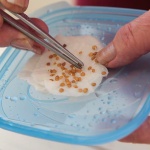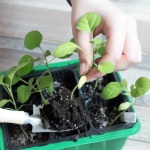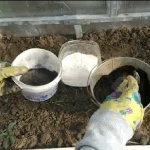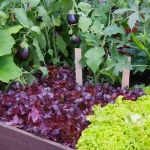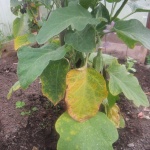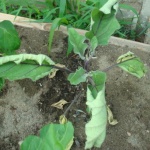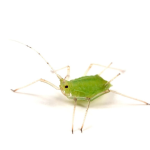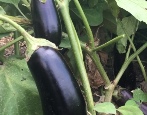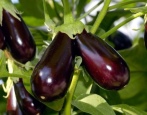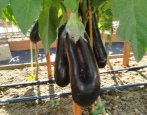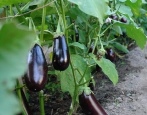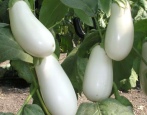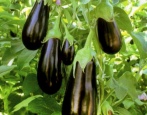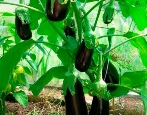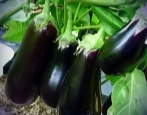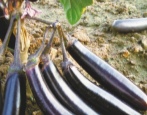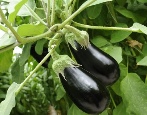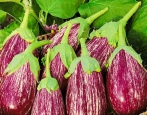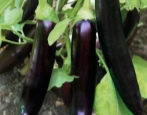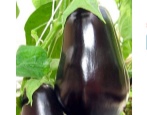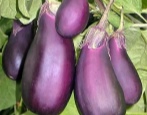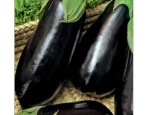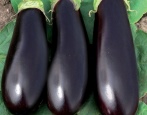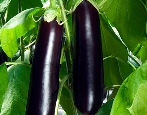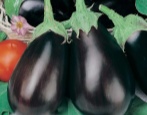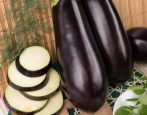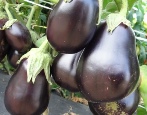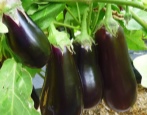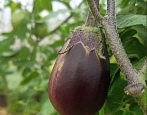
- Authors: Andrievsky A.S.
- Year of approval: 1983
- Bush height, cm: 45-56
- Fruit shape: cylindrical
- Fruit weight, g: 100-164
- Ripening terms: mid-season
- Pulp (consistency): dense
- Color of the pulp: greenish
- The period from germination to harvest: 109-149 depending on the region of cultivation
- Taste : no bitterness
Eggplant Diamond is a classic. The variety was bred almost 40 years ago, but is still in demand and respected.
Description of the variety
Diamond is an early, friendly, prolific eggplant with fruits of excellent taste and size. For its time, it was a breakthrough. Not possessing exotic characteristics, Almaz made a vivid impression. First, there was no bitterness in the fruit. The fruits themselves are very beautiful and neat. The plant is medium-sized, but lively, active, hung with fruits during the fruiting period. The variety was included in the Russian State Register in 1983. Originators: Intersemya LLC and Poisk agrofirm.
Characteristics of the appearance of plants and fruits
The bush is compact, 45-56 cm high. Begins early and amicably branching. Leaves are medium in size, wide. The petioles are green with purple veins. The flowers are light purple.
Fruits are cylindrical, classical in shape, slightly teardrop-shaped, not too long and not too thick, length - 14.5-17.5 cm, fruits reach 6 cm in diameter. Fruits are quite large - 100-164 grams. The color at the stage of technical ripeness is dark purple, the skin is glossy. The pulp is dense, greenish in color. The commercial qualities are excellent, the fruits lie well, look beautiful, and are easy to process.
Purpose and taste
The taste is excellent, without bitterness. The variety is versatile. The fruits are baked, fried, stuffed, rolled up for the winter: with tomatoes, nuts, zucchini. The variety does not need soaking, the pulp is firm, very convenient for culinary processing.
Ripening terms
The variety is mid-season, the fruits are harvested 109-149 days after the emergence of full shoots. The term varies depending on the conditions. Harvest amicable thanks to the rapid branching of the bush.
Yield
Productivity from 2.1 to 7.5 kg per 1 sq. m. Depends on agricultural technology. The variety is convenient for mechanized harvesting.
Growing regions
The variety is early ripe, quite hardy, it is officially approved for cultivation in traditional warm regions: the Central Black Earth Region, the North Caucasus. It is grown in quite fertile regions: Lower Volga and Middle Volga. The originators also allow cultivation of the variety in the Urals, Western Siberia and the Far East - in these three regions, eggplant cultivation is usually fraught with difficulties. Diamond is one of the best grades for these places. It is early ripe, fruitful, flexible. This will still require careful care.
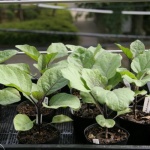
To get a tasty and bountiful eggplant crop, you must first grow strong and healthy seedlings. This culture is considered very capricious, therefore, you need to take care of seedlings when growing at home as correctly and carefully as possible.
Landing scheme
The distance between plants is 35-40 cm, in row spacings - 60 cm. If the seeds are sown directly into the ground for 10 sq. m will require 3 grams of seeds. Seedlings are thinned out so that there is 20-30 cm between the best specimens.
Growing and care
The growth rate and general qualities of Almaz make it a suitable choice for outdoor cultivation.
The most important points of agricultural technology for a variety.
- Before planting, the seeds are kept in a slightly pink solution of potassium permanganate.
- Sowing - only in soft, loose soil.
- 10 days after the emergence of seedlings, it is desirable to reduce the temperature from + 25 ° С to + 10 ° С.
- Every 15 days, the seedlings are fed with a urea solution - 15 g per 1 liter.
- Seedlings are planted in open ground when the soil warms up to + 15 ° C. Plants should have 4-5 true leaves or 6-7 each - if the seedlings are planted in a greenhouse.
- Watering should be done carefully, the plant has a superficial root system. Water when the topsoil dries out, on average 1 time per week or 10 waterings per season.
- Loosening is only superficial, no deeper than 1 cm, mulching is better.
- Potash fertilizers are very important - the plant is demanding on the potassium content in the soil.
- Before lignification of the stem, eggplant reacts positively to phosphorus fertilizers.
- Air humidity should be no higher than 70%.
The lower fruits of the variety touch the ground. Therefore, it is important that the earth is not dense and damp. It is best if the topsoil under the eggplants is chopped straw mulch.
Water only with soft, warm water with a temperature of + 20 ° C. The frequency of watering is highly dependent on the weather, if the soil dries out quickly, there is no rain, then you will need to water every 2 days. Moisture should saturate the soil by 20-30 cm.
Excessive watering is harmful - the roots of the culture are sensitive to soaking. It is better to water not at the root, but in special grooves.
You should not use foliar dressing - eggplants do not like spraying on the leaf. Plants are watered at the root, fertilizers should be dissolved only in warm water. The first top dressing is 2 weeks after planting in the ground. Use nettle infusion, mullein solution, ammophoska (20 grams per 10 liters of water), superphosphate and potassium chloride (30 g and 20 g per 10 liters of water). On 1 bush previously watered with water, 1 liter of fertilizer is poured.
During fruiting, you can use the same mixtures, only slightly increase the concentration of nutrients: 40 g of superphosphate per 10 liters of water, 2 tsp each. superphosphate and potassium salt per 10 liters of water, half a liter of chicken manure per 10 liters of water, 1 liter of mullein + ¼ l of chicken manure + 1 tbsp. l. urea per 10 liters of water.
In a cloudy summer, eggplants will need even more potash fertilizers than usual - this component can be increased by 1/5. Liquid potash can be replaced with wood ash. 1 cup of sifted wood ash is distributed over 1 sq. m, well loosened.
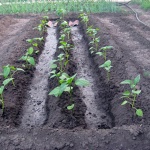
Planting eggplant is one of the most important stages in growing. When choosing a place for eggplants on your site, it is important to remember that this culture should be in warm soil, constantly illuminated by the sun. The plant is also very fond of spacious, open spaces, since its roots can grow over sufficient areas.


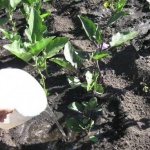
Soil requirements
Seedling soil is a nutritious, soft, quick-drying mixture of equal parts peat, sand and turf.For adult eggplants, the soil should also be loose, breathable, and very nutritious. In the spring, when digging into the soil, they are introduced into 1 sq. m half a bucket of humus, half a bucket of low-lying peat, 1 glass of sifted wood ash.
Required climatic conditions
Like all eggplants, Almaz loves an even warm temperature - + 25 ° С ... + 27 ° С. Plants are planted in bright, well-lit places.
Disease and pest resistance
The variety is relatively resistant to mosaic and pillar. This means that when it meets a pathogen, the plant will effectively resist it.
The variety is moderately susceptible to late blight, top rot of fruits, verticillium and fusarium wilting.
Preventive treatments are highly desirable.
Small spots that appear can be powdered with wood ash. Bushes affected by late blight are sprayed with copper-containing preparations or infusion of garlic.
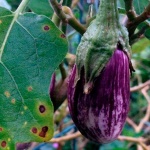
Eggplant is one of the most demanding crops. For its successful cultivation, it is necessary to create optimal conditions, as well as to carry out prevention and fight against diseases and pests. Eggplant often infects both fungal and viral diseases. If treatment is not started on time, you can completely lose the crop.
Review overview
The variety is officially recommended for commercial production. The single-caliber, plentiful fruits truly satisfy the needs of smallholder farmers. In individual cultivation, where agricultural technology is not so automated, the variety can produce a more contradictory impression - in a damp unstable summer, eggplants suffer from diseases. However, Almaz copes - almost all the reviews are extremely positive. The seeds sprout perfectly, the seedlings are lively and tenacious, they take root well in a new place, they do not freeze, the bushes are compact, the fruits are tasty, they do not need to be soaked from bitterness.
Gardeners, whose conditions are not suitable for the crop, noted that this is the most reliable variety of all. Yes, the fruits grow small, but other varieties do not give any yield at all. The Almaz variety is perfect for beginners - those who are just getting started with planting and growing eggplants.
